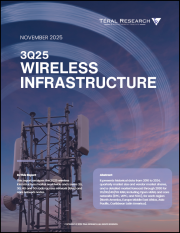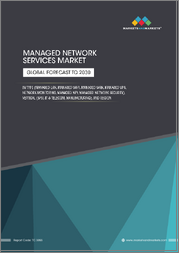
|
시장보고서
상품코드
1558287
야외 Wi-Fi 시장 예측(-2030년) : 구성요소별, 전개 방식별, 위치 유형별, 조직 규모별, 기술별, 최종사용자별, 지역별 세계 분석Outdoor Wi-Fi Market Forecasts to 2030 - Global Analysis By Component (Hardware, Software and Services), Deployment Type (Fixed and Mobile Outdoor Wi-Fi), Location Type, Organization Size, Technology, End User and By Geography |
||||||
Stratistics MRC에 따르면, 세계 실외 와이파이 시장은 2024년 164억 달러 규모이며, 예측 기간 동안 연평균 11.1% 성장하여 2030년에는 309억 달러에 달할 것으로 예상됩니다.
야외 Wi-Fi는 공원, 경기장, 경기장, 운동장, 대도시 공간과 같은 지역에서 웹 네트워크를 제공하기 위해 야외 조건을 위한 조직적인 조치입니다. 비바람에 견디는 하드웨어와 첨단 기술을 활용한 이 시스템은 광범위한 지역에서 고속 인터넷 접속을 가능하게 합니다. 야외 Wi-Fi는 종종 장거리 통로, 강력한 안전 조치, 다양한 클라이언트를 지원할 수 있는 높은 능력을 강조하며, 다양한 테스트가 수행되는 야외 조건에서 일관된 가용성과 실행을 보장합니다.
시스코에 따르면 96%의 고객이 기업 경험의 일부로 무료 Wi-Fi를 기대한다고 합니다.
스마트 시티 프로젝트에 대한 투자 확대
세계 스마트 시티 이니셔티브는 실외 와이파이 시장의 큰 성장을 촉진하고 있습니다. 이러한 프로젝트는 디지털 연결을 통해 도시 생활을 개선하는 것을 목표로 하고 있으며, 이를 위해서는 광범위한 야외 Wi-Fi 네트워크가 필요합니다. 정부와 지자체는 연결된 공공 공간을 구축하고, 시민 서비스를 개선하고, IoT 애플리케이션을 구현하기 위해 많은 투자를 하고 있습니다. 이러한 추세는 액세스 포인트, 컨트롤러 및 관리 소프트웨어를 포함한 야외 Wi-Fi 인프라에 대한 수요를 촉진하고 있습니다. 스마트 시티 프로젝트에서 Wi-Fi의 통합은 공공안전, 교통 관리, 환경 모니터링 등 다양한 애플리케이션을 지원하며, 실외 연결 솔루션의 시장 성장과 기술 혁신을 촉진하는 견고한 생태계를 구축하고 있습니다.
프라이버시 및 보안에 대한 우려의 증가
공공 와이파이 네트워크는 사이버 공격, 데이터 유출, 무단 액세스에 취약한 것으로 인식되기 쉽습니다. 사용자들은 개인정보 도난이나 악성코드 감염 가능성을 우려해 개방형 네트워크에 접속하는 것을 꺼려하는 경향이 있습니다. 이러한 우려는 야외 와이파이 서비스 도입 및 이용 감소로 이어질 수 있습니다.
스마트 인프라 솔루션과의 통합
야외 Wi-Fi와 스마트 인프라 솔루션의 통합은 시장 확대에 큰 기회가 될 수 있습니다. 도시와 조직이 IoT 기기, 스마트 센서 및 커넥티드 시스템을 점점 더 많이 채택함에 따라 야외 Wi-Fi 네트워크는 데이터 전송 및 연결의 중요한 중추 역할을 할 수 있습니다. 이러한 통합은 스마트 조명, 폐기물 관리, 환경 모니터링, 지능형 교통 시스템과 같은 고급 애플리케이션을 가능하게 합니다. 야외 Wi-Fi 인프라를 활용하면 스마트 솔루션은 보다 효율적이고 비용 효율적으로 운영될 수 있습니다. 이러한 시너지 효과는 와이파이 공급자에게 새로운 수익원을 창출하고, 실외 네트워크의 가치 제안을 강화하며, 시장 성장을 촉진할 수 있습니다.
모바일 네트워크 기술과의 경쟁
모바일 네트워크 기술, 특히 4G와 5G의 급속한 발전과 보급은 야외 Wi-Fi 시장에 큰 위협이 될 것입니다. 이러한 모바일 네트워크는 광범위한 커버리지, 빠른 연결성, 향상된 이동성을 제공하여 별도의 야외 Wi-Fi 인프라를 구축할 필요성을 줄일 수 있으며, 5G 네트워크가 확장되면 많은 실외 시나리오에서 Wi-Fi와 동등하거나 그 이상의 성능을 제공할 수 있을 것으로 예상됩니다. 이러한 경쟁은 특히 휴대폰 커버리지가 강한 지역에서 실외 와이파이 프로젝트에 대한 투자를 감소시킬 수 있습니다.
COVID-19의 영향:
COVID-19 사태로 인해 처음에는 문단속과 예산 제약으로 인해 실외 와이파이의 보급이 지연되었습니다. 그러나 이후 원격 근무, 원격 학습 및 비대면 서비스를 지원하기 위한 야외 연결에 대한 수요가 가속화되었습니다. 이러한 변화는 견고한 야외 Wi-Fi 인프라의 중요성을 부각시켰고, 실외 연결 솔루션의 장기적인 시장 성장과 기술 혁신을 촉진했습니다.
예측 기간 동안 하드웨어 분야가 가장 큰 비중을 차지할 것으로 예상됩니다.
하드웨어 분야가 실외 와이파이 시장을 독점할 것으로 예상됩니다. 이러한 우위는 야외 Wi-Fi 네트워크의 확장 및 업그레이드를 위한 물리적 인프라의 지속적인 필요성에 기인합니다. 스마트 시티 개념이 확대되고 고속 실외 연결에 대한 수요가 증가함에 따라 새로운 하드웨어의 배포 및 교체가 지속적으로 요구되며, Wi-Fi 표준의 진화는 하드웨어 업그레이드를 촉진하고 더 나은 성능과 용량을 보장합니다. 또한, 실외 장비의 내구성 요구 사항은 비용 상승과 잦은 교체로 인해 하드웨어 부문의 시장 점유율을 더욱 높이고 있습니다.
Wi-Fi 6(802.11ax) 부문은 예측 기간 동안 가장 높은 CAGR을 기록할 것으로 예상됩니다.
Wi-Fi 6(802.11ax) 부문은 뛰어난 성능 특성으로 인해 야외 Wi-Fi 시장에서 가장 높은 성장률을 보일 것으로 예상됩니다. Wi-Fi 6 표준은 데이터 속도 향상, 용량 증가, 전력 효율 개선, 혼잡한 지역에서의 성능 향상 등 실외 구축에 필수적인 성능을 제공하며, Wi-Fi 6 지원 기기의 보급과 실외 환경에서의 광대역 애플리케이션에 대한 수요 증가로 인해 Wi-Fi 6 인프라의 급속한 보급을 촉진하고 시장 성장을 견인할 것으로 예상됩니다. 의 급속한 보급을 촉진하고 시장 성장을 촉진하고 있습니다.
최대 점유율 지역:
예측 기간 동안 북미가 실외 와이파이 시장을 장악할 것으로 보입니다. 이러한 우위는 이 지역의 첨단 기술 인프라, 새로운 Wi-Fi 표준의 조기 채택, 스마트 시티 프로젝트에 대한 막대한 투자에 기인합니다. 북미에는 원활한 야외 연결을 원하는 기술적으로 진보된 소비자와 기업이 집중되어 있습니다. 또한, 공공 와이파이와 디지털 포용을 촉진하는 정부 이니셔티브는 도시와 농촌 지역에 걸쳐 야외 와이파이 네트워크의 광범위한 확산에 기여하고 있으며, 북미 시장에서의 선도적 지위를 공고히 하고 있습니다.
CAGR이 가장 높은 지역:
예측 기간 동안 아시아태평양은 야외 Wi-Fi 시장에서 급성장할 것으로 예상됩니다. 이러한 높은 성장률은 급속한 도시화, 인터넷 보급률 증가, 중국, 인도, 동남아시아 국가 등 신흥 경제권의 디지털 인프라에 대한 대대적인 투자에 힘입은 바 큽니다. 스마트 시티와 디지털 연결을 촉진하는 정부 이니셔티브는 실외 와이파이 보급을 더욱 가속화할 것입니다. 이 지역의 E-Commerce, 디지털 결제 및 모바일 서비스 확대는 Wi-Fi 보급에 의존하는 견고한 생태계를 구축하여 아시아태평양 시장의 급속한 성장에 기여하고 있습니다.
무료 맞춤형 서비스:
이 보고서를 구독하는 고객에게는 다음과 같은 무료 맞춤화 옵션 중 하나를 제공합니다.
- 기업 개요
- 추가 시장 기업의 종합적인 프로파일링(최대 3개사까지)
- 주요 기업 SWOT 분석(최대 3개사)
- 지역 세분화
- 고객의 관심에 따른 주요 국가별 시장 추정치, 예측, CAGR(주 : 타당성 검토에 따른)
- 경쟁사 벤치마킹
- 제품 포트폴리오, 지리적 입지, 전략적 제휴를 기반으로 한 주요 기업 벤치마킹
목차
제1장 주요 요약
제2장 서문
- 개요
- 이해관계자
- 조사 범위
- 조사 방법
- 데이터 마이닝
- 데이터 분석
- 데이터 검증
- 조사 접근법
- 조사 정보 출처
- 1차 조사 정보 출처
- 2차 조사 정보 출처
- 가정
제3장 시장 동향 분석
- 성장 촉진요인
- 성장 억제요인
- 기회
- 위협
- 최종사용자 분석
- 신흥 시장
- COVID-19의 영향
제4장 Porter's Five Forces 분석
- 공급 기업의 교섭력
- 구매자의 교섭력
- 대체품의 위협
- 신규 참여업체의 위협
- 경쟁 기업 간의 경쟁 관계
제5장 세계의 야외 Wi-Fi 시장 : 구성요소별
- 하드웨어
- 액세스 포인트
- WLAN 컨트롤러
- 메시 네트워크
- 무선 핫스팟 게이트웨이
- 기타 하드웨어
- 소프트웨어
- 네트워크 관리
- 네트워크 보안
- 분석과 위치기반서비스
- 기타 소프트웨어
- 서비스
- 전문 서비스
- 매니지드 서비스
제6장 세계의 야외 Wi-Fi 시장 : 전개 방식별
- 고정 야외 Wi-Fi
- 모바일 야외 Wi-Fi
제7장 세계의 야외 Wi-Fi 시장 : 로케이션 유형별
- 자치체 네트워크
- 공공시설
- 야외 스마트 시티 프로젝트
- 야외 학습 환경
- 야외 경기장
- 기타 로케이션 유형
제8장 세계의 야외 Wi-Fi 시장 : 조직 규모별
- 대기업
- 중소기업
제9장 세계의 야외 Wi-Fi 시장 : 기술별
- Wi-Fi 4(802.11n)
- Wi-Fi 5(802.11ac)
- Wi-Fi 6(802.11ax)
- Wi-Fi 6E
- 기타 기술
제10장 세계의 야외 Wi-Fi 시장 : 최종사용자별
- 정부
- 소매
- 교육
- 헬스케어
- 운송·물류
- 여행·호스피탈리티
- 기타 최종사용자
제11장 세계의 야외 Wi-Fi 시장 : 지역별
- 북미
- 미국
- 캐나다
- 멕시코
- 유럽
- 독일
- 영국
- 이탈리아
- 프랑스
- 스페인
- 기타 유럽
- 아시아태평양
- 일본
- 중국
- 인도
- 호주
- 뉴질랜드
- 한국
- 기타 아시아태평양
- 남미
- 아르헨티나
- 브라질
- 칠레
- 기타 남미
- 중동 및 아프리카
- 사우디아라비아
- 아랍에미리트
- 카타르
- 남아프리카공화국
- 기타 중동 및 아프리카
제12장 주요 발전
- 계약, 파트너십, 협업, 합작투자
- 인수와 합병
- 신제품 발매
- 사업 확대
- 기타 주요 전략
제13장 기업 개요
- Cisco Systems Inc.
- Hewlett-Packard Enterprise Company
- Aerohive Networks
- Airspan Networks
- Alvarion Technologies(SuperCom)
- Fortinet Inc.
- Extreme Networks
- Huawei
- Juniper Networks
- Panasonic
- Alcatel-Lucent Enterprise
- NETGEAR
- Broadcom
- Ubiquiti Networks
- Cambium Networks
- Qualcomm Technologies, Inc.
- Ericsson
According to Stratistics MRC, the Global Outdoor Wi-Fi Market is accounted for $16.4 billion in 2024 and is expected to reach $30.9 billion by 2030 growing at a CAGR of 11.1% during the forecast period. Outside Wi-Fi are organizing arrangements intended for open-air conditions, providing web networks in regions like parks, arenas, grounds, and metropolitan spaces. High-speed internet access over large areas is made possible by these systems, which make use of weather-resistant hardware and cutting-edge technologies. Open air Wi-Fi arrangements frequently highlight long-range passages, strong safety efforts, and high ability to help different clients, guaranteeing consistent availability and execution in assorted and testing outside conditions.
According to Cisco 96% of customers expect free Wi-Fi as part of their experience at businesses.
Market Dynamics:
Driver:
Growing investments in smart city projects
Smart city initiatives worldwide are driving significant growth in the outdoor Wi-Fi market. These projects aim to enhance urban living through digital connectivity, requiring extensive outdoor Wi-Fi networks. Governments and municipalities are investing heavily in creating connected public spaces, improving citizen services, and enabling IoT applications. This trend fuels demand for outdoor Wi-Fi infrastructure, including access points, controllers, and management software. The integration of Wi-Fi in smart city projects supports various applications like public safety, traffic management, and environmental monitoring, creating a robust ecosystem that propels market growth and innovation in outdoor connectivity solutions.
Restraint:
Rising privacy and security concerns
Public Wi-Fi networks are often perceived as vulnerable to cyber attacks, data breaches, and unauthorized access. Users are increasingly wary of connecting to open networks, fearing potential theft of personal information or exposure to malware. These concerns can lead to reduced adoption and usage of outdoor Wi-Fi services.
Opportunity:
Integration with smart infrastructure solutions
The integration of outdoor Wi-Fi with smart infrastructure solutions presents a significant opportunity for market expansion. As cities and organizations increasingly adopt IoT devices, smart sensors, and connected systems, outdoor Wi-Fi networks serve as the crucial backbone for data transmission and connectivity. This integration enables advanced applications such as smart lighting, waste management, environmental monitoring, and intelligent transportation systems. By leveraging outdoor Wi-Fi infrastructure, smart solutions can operate more efficiently and cost-effectively. This synergy creates new revenue streams for Wi-Fi providers, enhances the value proposition of outdoor networks, and fosters market growth.
Threat:
Competition from mobile network technologies
The rapid advancement and deployment of mobile network technologies, particularly 4G and 5G, pose a significant threat to the outdoor Wi-Fi market. These cellular networks offer widespread coverage, high-speed connectivity, and improved mobility, potentially reducing the need for separate outdoor Wi-Fi infrastructure. As 5G networks expand, they can provide comparable or superior performance to Wi-Fi in many outdoor scenarios. This competition may lead to reduced investment in outdoor Wi-Fi projects, especially in areas with strong cellular coverage.
Covid-19 Impact:
The COVID-19 pandemic initially slowed outdoor Wi-Fi deployments due to lockdowns and budget constraints. However, it subsequently accelerated demand for outdoor connectivity to support remote work, distance learning, and contactless services. This shift highlighted the importance of robust outdoor Wi-Fi infrastructure, driving long-term market growth and innovation in outdoor connectivity solutions.
The hardware segment is expected to be the largest during the forecast period
The hardware segment is projected to dominate the outdoor Wi-Fi market. This dominance is attributed to the continuous need for physical infrastructure to expand and upgrade outdoor Wi-Fi networks. As smart city initiatives grow and demand for high-speed outdoor connectivity increases, there's a constant requirement for new hardware deployments and replacements. The evolution of Wi-Fi standards drives hardware upgrades, ensuring better performance and capacity. Additionally, the durability requirements for outdoor equipment contribute to higher costs and frequent replacements, further boosting the hardware segment's market share.
The Wi-Fi 6 (802.11ax) segment is expected to have the highest CAGR during the forecast period
The Wi-Fi 6 (802.11ax) segment is anticipated to experience the highest growth rate in the outdoor Wi-Fi market due to its superior performance characteristics. This standard offers significantly higher data rates, increased capacity, improved power efficiency, and better performance in congested areas, all of which are crucial for outdoor deployments. The growing adoption of Wi-Fi 6 compatible devices and the increasing demand for high-bandwidth applications in outdoor settings drive the rapid deployment of Wi-Fi 6 infrastructure, fueling its market growth.
Region with largest share:
During the forecast period, the North American region is expected to dominate the outdoor Wi-Fi market. This dominance is attributed to the region's advanced technological infrastructure, early adoption of new Wi-Fi standards, and significant investments in smart city projects. North America boasts a high concentration of tech-savvy consumers and businesses demanding seamless outdoor connectivity. Additionally, government initiatives promoting public Wi-Fi and digital inclusion contribute to the extensive deployment of outdoor Wi-Fi networks across urban and rural areas, solidifying North America's leading position in the market.
Region with highest CAGR:
During the forecast period, the Asia Pacific region is expected to witness rapid growth in the outdoor Wi-Fi market. This high growth rate is driven by rapid urbanization, increasing internet penetration, and substantial investments in digital infrastructure across emerging economies like China, India, and Southeast Asian countries. Government initiatives promoting smart cities and digital connectivity further accelerate outdoor Wi-Fi deployments. The expansion of e-commerce, digital payments, and mobile services in the region creates a robust ecosystem that relies on widespread Wi-Fi availability, contributing to the rapid market growth in Asia Pacific.
Key players in the market
Some of the key players in Outdoor Wi-Fi market include Cisco Systems Inc., Hewlett-Packard Enterprise Company, Aerohive Networks, Airspan Networks, Alvarion Technologies (SuperCom), Fortinet Inc., Extreme Networks, Huawei, Juniper Networks, Panasonic, Alcatel-Lucent Enterprise, NETGEAR, Broadcom, Ubiquiti Networks, Cambium Networks, Qualcomm Technologies, Inc., and Ericsson.
Key Developments:
In June 2024, Hewlett Packard Enterprise introduced HPE Aruba Networking Enterprise Private 5G to help customers accelerate and simplify the deployment and management of private 5G networks, providing high levels of reliable wireless coverage across large campus and industrial environments and opening up new, untapped use cases for private cellular.
In May 2024, Cambium Networks, a leading global provider of broadband networking solutions, announced that enterprises, municipalities, and system integrators are successfully deploying private outdoor wireless networks to campuses, cities, resorts, and warehouses more efficiently and cost-effectively with Cambium ONE Network solutions.
In April 2024, Extreme Networks, Inc, a leader in cloud networking, today announced that it's the first vendor with outdoor Wi-Fi 6E deployments to receive a standard power grant - allowing customers to leverage faster speeds, increased range of coverage and expanded capacity for outdoor connectivity. In partnership with Wi-Fi Alliance Services, Extreme now offers deployed customers such as BYU, Cedar Fair and the San Francisco Giants the ability to provide uninterrupted 6 GHz Wi-Fi(R) connectivity, expanded coverage, lower latency and improved performance of devices across outdoor environments.
Product Types Covered:
- Hardware
- Software
- Services
Deployment Types Covered:
- Fixed Outdoor Wi-Fi
- Mobile Outdoor Wi-Fi
Location Types Covered:
- Municipal Networks
- Public Venues
- Outdoor Smart City Projects
- Outdoor Learning Environments
- Outdoor Sports Venues
- Other Location Types
Organization Sizes Covered:
- Large Enterprises
- Small & Medium Enterprises
Technologies Covered:
- Wi-Fi 4 (802.11n)
- Wi-Fi 5 (802.11ac)
- Wi-Fi 6 (802.11ax)
- Wi-Fi 6E
- Other Technologies
End Users Covered:
- Government
- Retail
- Education
- Healthcare
- Transportation & Logistics
- Travel & Hospitality
- Other End Users
Regions Covered:
- North America
- US
- Canada
- Mexico
- Europe
- Germany
- UK
- Italy
- France
- Spain
- Rest of Europe
- Asia Pacific
- Japan
- China
- India
- Australia
- New Zealand
- South Korea
- Rest of Asia Pacific
- South America
- Argentina
- Brazil
- Chile
- Rest of South America
- Middle East & Africa
- Saudi Arabia
- UAE
- Qatar
- South Africa
- Rest of Middle East & Africa
What our report offers:
- Market share assessments for the regional and country-level segments
- Strategic recommendations for the new entrants
- Covers Market data for the years 2022, 2023, 2024, 2026, and 2030
- Market Trends (Drivers, Constraints, Opportunities, Threats, Challenges, Investment Opportunities, and recommendations)
- Strategic recommendations in key business segments based on the market estimations
- Competitive landscaping mapping the key common trends
- Company profiling with detailed strategies, financials, and recent developments
- Supply chain trends mapping the latest technological advancements
Free Customization Offerings:
All the customers of this report will be entitled to receive one of the following free customization options:
- Company Profiling
- Comprehensive profiling of additional market players (up to 3)
- SWOT Analysis of key players (up to 3)
- Regional Segmentation
- Market estimations, Forecasts and CAGR of any prominent country as per the client's interest (Note: Depends on feasibility check)
- Competitive Benchmarking
- Benchmarking of key players based on product portfolio, geographical presence, and strategic alliances
Table of Contents
1 Executive Summary
2 Preface
- 2.1 Abstract
- 2.2 Stake Holders
- 2.3 Research Scope
- 2.4 Research Methodology
- 2.4.1 Data Mining
- 2.4.2 Data Analysis
- 2.4.3 Data Validation
- 2.4.4 Research Approach
- 2.5 Research Sources
- 2.5.1 Primary Research Sources
- 2.5.2 Secondary Research Sources
- 2.5.3 Assumptions
3 Market Trend Analysis
- 3.1 Introduction
- 3.2 Drivers
- 3.3 Restraints
- 3.4 Opportunities
- 3.5 Threats
- 3.6 End User Analysis
- 3.7 Emerging Markets
- 3.8 Impact of Covid-19
4 Porters Five Force Analysis
- 4.1 Bargaining power of suppliers
- 4.2 Bargaining power of buyers
- 4.3 Threat of substitutes
- 4.4 Threat of new entrants
- 4.5 Competitive rivalry
5 Global Outdoor Wi-Fi Market, By Component
- 5.1 Introduction
- 5.2 Hardware
- 5.2.1 Access Points
- 5.2.2 WLAN Controllers
- 5.2.3 Mesh Networks
- 5.2.4 Wireless Hotspot Gateways
- 5.2.5 Other Hardware
- 5.3 Software
- 5.3.1 Network Management
- 5.3.2 Network Security
- 5.3.3 Analytics & Location Services
- 5.3.4 Other Software
- 5.4 Services
- 5.4.1 Professional Services
- 5.4.2 Managed Services
6 Global Outdoor Wi-Fi Market, By Deployment Type
- 6.1 Introduction
- 6.2 Fixed Outdoor Wi-Fi
- 6.3 Mobile Outdoor Wi-Fi
7 Global Outdoor Wi-Fi Market, By Location Type
- 7.1 Introduction
- 7.2 Municipal Networks
- 7.3 Public Venues
- 7.4 Outdoor Smart City Projects
- 7.5 Outdoor Learning Environments
- 7.6 Outdoor Sports Venues
- 7.7 Other Location Types
8 Global Outdoor Wi-Fi Market, By Organization Size
- 8.1 Introduction
- 8.2 Large Enterprises
- 8.3 Small & Medium Enterprises
9 Global Outdoor Wi-Fi Market, By Technology
- 9.1 Introduction
- 9.2 Wi-Fi 4 (802.11n)
- 9.3 Wi-Fi 5 (802.11ac)
- 9.4 Wi-Fi 6 (802.11ax)
- 9.5 Wi-Fi 6E
- 9.6 Other Technologies
10 Global Outdoor Wi-Fi Market, By End User
- 10.1 Introduction
- 10.2 Government
- 10.3 Retail
- 10.4 Education
- 10.5 Healthcare
- 10.6 Transportation & Logistics
- 10.7 Travel & Hospitality
- 10.8 Other End Users
11 Global Outdoor Wi-Fi Market, By Geography
- 11.1 Introduction
- 11.2 North America
- 11.2.1 US
- 11.2.2 Canada
- 11.2.3 Mexico
- 11.3 Europe
- 11.3.1 Germany
- 11.3.2 UK
- 11.3.3 Italy
- 11.3.4 France
- 11.3.5 Spain
- 11.3.6 Rest of Europe
- 11.4 Asia Pacific
- 11.4.1 Japan
- 11.4.2 China
- 11.4.3 India
- 11.4.4 Australia
- 11.4.5 New Zealand
- 11.4.6 South Korea
- 11.4.7 Rest of Asia Pacific
- 11.5 South America
- 11.5.1 Argentina
- 11.5.2 Brazil
- 11.5.3 Chile
- 11.5.4 Rest of South America
- 11.6 Middle East & Africa
- 11.6.1 Saudi Arabia
- 11.6.2 UAE
- 11.6.3 Qatar
- 11.6.4 South Africa
- 11.6.5 Rest of Middle East & Africa
12 Key Developments
- 12.1 Agreements, Partnerships, Collaborations and Joint Ventures
- 12.2 Acquisitions & Mergers
- 12.3 New Product Launch
- 12.4 Expansions
- 12.5 Other Key Strategies
13 Company Profiling
- 13.1 Cisco Systems Inc.
- 13.2 Hewlett-Packard Enterprise Company
- 13.3 Aerohive Networks
- 13.4 Airspan Networks
- 13.5 Alvarion Technologies (SuperCom)
- 13.6 Fortinet Inc.
- 13.7 Extreme Networks
- 13.8 Huawei
- 13.9 Juniper Networks
- 13.10 Panasonic
- 13.11 Alcatel-Lucent Enterprise
- 13.12 NETGEAR
- 13.13 Broadcom
- 13.14 Ubiquiti Networks
- 13.15 Cambium Networks
- 13.16 Qualcomm Technologies, Inc.
- 13.17 Ericsson



















